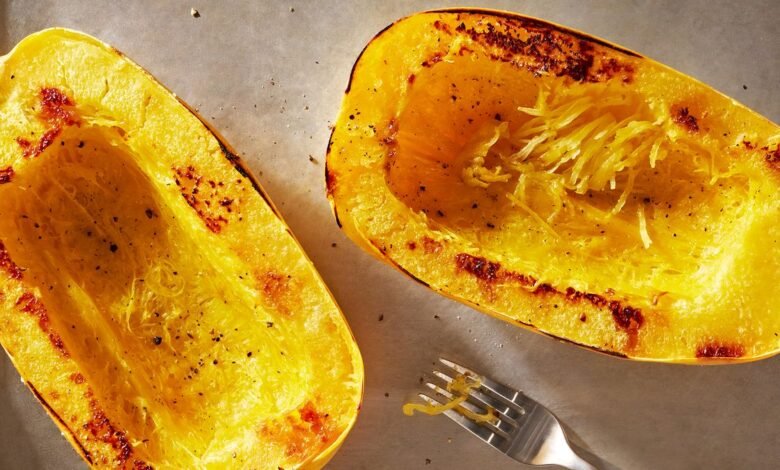How to Cook Spaghetti Squash

Spaghetti squash, with its unique texture and sweet, nutty flavor, has become a beloved staple for those seeking a healthy, versatile alternative to traditional pasta. Cooking spaghetti squash might seem daunting at first, but this comprehensive guide will walk you through everything you need to know about turning this winter squash into delicious meals. Whether you’re looking to incorporate more vegetables into your diet or simply love the idea of a pasta substitute that’s low in calories and rich in nutrients, mastering spaghetti squash will open up a world of culinary possibilities.
Selecting and Preparing Your Squash
Choosing the Perfect Spaghetti Squash
The journey to a delicious spaghetti squash dish begins at the grocery store or farmers market. Look for squash that feels heavy for its size, with a hard, unblemished rind. The color should be uniform, ranging from pale yellow to a deep, golden hue, depending on the variety. Avoid squash with soft spots or cracks, as these can indicate spoilage or poor quality.
Preparing the Squash for Cooking
Before you cook your spaghetti squash, it needs to be prepared. Start by washing the exterior of the squash under running water to remove any dirt or debris. Then, using a sharp chef’s knife, cut the squash in half lengthwise. This can require a bit of effort, so be careful and take your time. Once halved, use a spoon to scoop out and discard the seeds and fibrous strings from the center. Your squash is now ready to be cooked in your chosen method.
Cooking Methods
Spaghetti squash can be cooked using various methods, each yielding slightly different textures and flavors. Below are the most popular methods, along with step-by-step instructions.
Roasting: Enhancing Flavor
Roasting is a favorite method for cooking spaghetti squash due to the caramelization it produces, enhancing the squash’s natural sweetness. Preheat your oven to 400°F (200°C). After preparing the squash, brush the cut sides with olive oil and season with salt and pepper. Place the squash cut side down on a baking sheet lined with parchment paper. Roast for 40 to 60 minutes, depending on the size of the squash, until the flesh is tender and easily shreds with a fork. Roasting time can vary, so start checking for doneness after 30 minutes.
Microwaving: A Quick Alternative
For those short on time, microwaving spaghetti squash is a quick and efficient method. Prepare the squash as described, then place the halves cut side down in a microwave-safe dish. Add a little water to the dish (about an inch) to help steam the squash. Microwave on high for about 10 to 15 minutes, checking for doneness periodically. The squash is ready when the flesh is tender and separates easily into strands.
Boiling: Simple and Foolproof
Boiling spaghetti squash is another simple method, although it might not yield the same depth of flavor as roasting. Fill a large pot with water, salt it lightly, and bring it to a boil. Add the prepared squash halves and cook for about 20 to 30 minutes, or until the flesh is tender. This method is ideal for those who prefer a softer texture similar to pasta.
Steaming: Retaining Nutrients
Steaming spaghetti squash is a great way to retain its nutrients while achieving a tender texture. Prepare a pot with a steamer basket and fill the bottom with water, ensuring it doesn’t touch the basket. Place the squash halves in the basket, cut side up, cover, and steam for about 20 to 30 minutes. The squash is done when you can easily pierce it with a fork.
Serving Suggestions
Transforming Squash into “Spaghetti”
Once your spaghetti squash is cooked, let it cool for a few minutes until it’s safe to handle. Then, using a fork, scrape the flesh to create spaghetti-like strands. You’ll be amazed at how easily the squash separates into noodle-like pieces, ready to be topped with your favorite sauces and ingredients.
Pairing with Sauces and Toppings
Spaghetti squash is incredibly versatile and pairs well with a wide range of flavors. For a classic dish, top it with marinara sauce and a sprinkle of Parmesan cheese. Or, for a heartier meal, consider a Bolognese or creamy Alfredo sauce. Spaghetti squash also shines in more creative dishes, such as tossed with pesto, mixed with sautéed vegetables, or even used as a base for a taco-style filling.
Nutritional Benefits
In addition to its delicious taste and versatility, spaghetti squash is packed with nutrients, making it a healthy addition to any meal. It’s low in calories but high in fiber, vitamin C, manganese, and vitamin B6, among other vitamins and minerals. Incorporating spaghetti squash into your diet is a tasty way to enjoy a multitude of health benefits.
Conclusion
Cooking spaghetti squash is a simple and rewarding process that yields a versatile ingredient suitable for a myriad of dishes. Whether you prefer to roast, microwave, boil, or steam, each method brings out the unique texture and flavor of this beloved squash. Paired with your favorite sauces and toppings, spaghetti squash can be transformed into a nutritious and satisfying meal that’s sure to impress. With this comprehensive guide, you’re now equipped to select, prepare, and cook spaghetti squash like a pro, opening the door to countless delicious and healthy culinary creations.
Read Also: How to Change iPhone Name




